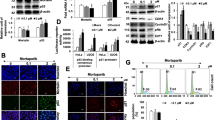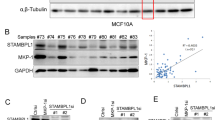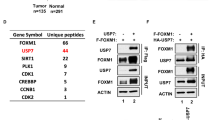Abstract
Overexpression of the oncoprotein mortalin in cancer cells and its protein partners enables mortalin to promote multiple oncogenic signaling pathways and effectively antagonize chemotherapy-induced cell death. A UBX-domain-containing protein, UBXN2A, acts as a potential mortalin inhibitor. This current study determines whether UBXN2A effectively binds to and occupies mortalin’s binding pocket, resulting in a direct improvement in the tumor’s sensitivity to chemotherapy. Molecular modeling of human mortalin’s binding pocket and its binding to the SEP domain of UBXN2A followed by yeast two-hybrid and His-tag pull-down assays revealed that three amino acids (PRO442, ILE558, and LYS555) within the substrate-binding domain of mortalin are crucial for UBXN2A binding to mortalin. As revealed by chase experiments in the presence of cycloheximide, overexpression of UBXN2A seems to interfere with the mortalin-CHIP E3 ubiquitin ligase and consequently suppresses the C‐terminus of the HSC70‐interacting protein (CHIP)-mediated destabilization of p53, resulting in its stabilization in the cytoplasm and upregulation in the nucleus. Overexpression of UBXN2A causes a significant inhibition of cell proliferation and the migration of colon cancer cells. We silenced UBXN2A in the human osteosarcoma U2OS cell line, an enriched mortalin cancer cell, followed by a clinical dosage of the chemotherapeutic agent 5-fluorouracil (5-FU). The UBXN2A knockout U2OS cells revealed that UBXNA is essential for the cytotoxic effect achieved by 5-FU. UBXN2A overexpression markedly increased the apoptotic response of U2OS cells to the 5-FU. In addition, silencing of UBXN2A protein suppresses apoptosis enhanced by UBXN2A overexpression in U2OS. The knowledge gained from this study provides insights into the mechanistic role of UBXN2A as a potent mortalin inhibitor and as a potential chemotherapy sensitizer for clinical application.






Similar content being viewed by others
References
Abdullah A, Sane S, Branick KA, Freeling JL, Wang H, Zhang D, Rezvani K (2015a) A plant alkaloid, veratridine, potentiates cancer chemosensitivity by UBXN2A-dependent inhibition of an oncoprotein, mortalin-2 Oncotarget 6(27):23561–23581
Abdullah A, Sane S, Freeling JL, Wang H, Zhang D, Rezvani K (2015b) Nucleocytoplasmic translocation of UBXN2A is required for apoptosis during DNA damage stresses in colon cancer cells. J Cancer 6:1066–1078
Arnold K, Bordoli L, Kopp J, Schwede T (2006) The SWISS-MODEL workspace: a web-based environment for protein structure homology modelling. Bioinformatics 22:195–201
Basu-Roy U, Basilico C, Mansukhani A (2013) Perspectives on cancer stem cells in osteosarcoma. Cancer Lett 338:158–167
Belmokhtar CA, Hillion J, Segal-Bendirdjian E (2001) Staurosporine induces apoptosis through both caspase-dependent and caspase-independent mechanisms. Oncogene 20:3354–3362
Bhattacharya A, Tejero R, Montelione GT (2007) Evaluating protein structures determined by structural genomics consortia. Proteins 66:778–795
Biasini M et al (2014) SWISS-MODEL: modelling protein tertiary and quaternary structure using evolutionary information. Nucleic Acids Res 42:W252–258
Chen J et al (2014) Overexpression of mortalin in hepatocellular carcinoma and its relationship with angiogenesis and epithelial to mesenchymal transition. Int J Oncol 44:247–255
Comeau SR, Gatchell DW, Vajda S, Camacho CJ (2004) ClusPro: an automated docking and discrimination method for the prediction of protein complexes. Bioinformatics 20:45–50
Conte M, Deri P, Isolani ME, Mannini L, Batistoni R (2009) A mortalin-like gene is crucial for planarian stem cell viability. Dev Biol 334:109–118
Deocaris CC, Lu WJ, Kaul SC, Wadhwa R (2013) Druggability of mortalin for cancer and neuro-degenerative disorders. Curr Pharm Des 19:418–429
Dundas SR, Lawrie LC, Rooney PH, Murray GI (2005) Mortalin is over-expressed by colorectal adenocarcinomas and correlates with poor survival. J Pathol 205:74–81
Eby KG et al (2010) ISG20L1 is a p53 family target gene that modulates genotoxic stress-induced autophagy. Mol Cancer 9:95
Ehemann V, Sykora J, Vera-Delgado J, Lange A, Otto HF (2003) Flow cytometric detection of spontaneous apoptosis in human breast cancer using the TUNEL-technique. Cancer Lett 194:125–131
Esser C, Scheffner M, Hohfeld J (2005) The chaperone-associated ubiquitin ligase CHIP is able to target p53 for proteasomal degradation. J Biol Chem 280:27443–27448
Fiszer-Kierzkowska A, Vydra N, Wysocka-Wycisk A, Kronekova Z, Jarzab M, Lisowska KM, Krawczyk Z (2011) Liposome-based DNA carriers may induce cellular stress response and change gene expression pattern in transfected cells. BMC Mol Biol 12:27
Gestl EE, Anne Bottger S (2012) Cytoplasmic sequestration of the tumor suppressor p53 by a heat shock protein 70 family member, mortalin, in human colorectal adenocarcinoma cell lines. Biochem Biophys Res Commun 423:411–416
Grover A et al (2012) Withanone binds to mortalin and abrogates mortalin-p53 complex: computational and experimental evidence. Int J Biochem Cell Biol 44:496–504
Guo W et al (2014) Targeting GRP75 improves HSP90 inhibitor efficacy by enhancing p53-mediated apoptosis in hepatocellular carcinoma. PLoS One 9:e85766
Hattinger CM, Pasello M, Ferrari S, Picci P, Serra M (2010) Emerging drugs for high-grade osteosarcoma. Expert Opin Emerg Drugs 15:615–634. doi:10.1517/14728214.2010.505603
Iosefson O, Azem A (2010) Reconstitution of the mitochondrial Hsp70 (mortalin)-p53 interaction using purified proteins—identification of additional interacting regions. FEBS Lett 584:1080–1084. doi:10.1016/j.febslet.2010.02.019
Kaul SC, Reddel RR, Mitsui Y, Wadhwa R (2001) An N-terminal region of mot-2 binds to p53 in vitro. Neoplasia 3:110–114
Kaul Z, Yaguchi T, Kaul SC, Hirano T, Wadhwa R, Taira K (2003) Mortalin imaging in normal and cancer cells with quantum dot immuno-conjugates. Cell Res 13:503–507
Kaul SC, Aida S, Yaguchi T, Kaur K, Wadhwa R (2005) Activation of wild type p53 function by its mortalin-binding, cytoplasmically localizing carboxyl terminus peptides. J Biol Chem 280:39373–39379. doi:10.1074/jbc.M500022200
Kaul SC, Deocaris CC, Wadhwa R (2007) Three faces of mortalin: a housekeeper, guardian and killer. Exp Gerontol 42:263–274. doi:10.1016/j.exger.2006.10.020
Kern M, Fernandez-Saiz V, Schafer Z, Buchberger A (2009) UBXD1 binds p97 through two independent binding sites. Biochem Biophys Res Commun 380:303–307
Kim SY, Helman LJ (2009) Strategies to explore new approaches in the investigation and treatment of osteosarcoma. Cancer Treat Res 152:517–528
Kim HJ, Chalmers PN, Morris CD (2010) Pediatric osteogenic sarcoma. Curr Opin Pediatr 22:61–66
Kozakov D, Beglov D, Bohnuud T, Mottarella SE, Xia B, Hall DR, Vajda S (2013) How good is automated protein docking? Proteins 81:2159–2166
Krieger E, Vriend G (2015) New ways to boost molecular dynamics simulations. J Comput Chem 36:996–1007
Krieger E, Dunbrack RL Jr, Hooft RW, Krieger B (2012) Assignment of protonation states in proteins and ligands: combining pKa prediction with hydrogen bonding network optimization. Methods Mol Biol 819:405–421
Lee JT, Gu W (2010) The multiple levels of regulation by p53 ubiquitination. Cell Death Differ 17:86–92. doi:10.1038/cdd.2009.77
Lu WJ, Lee NP, Kaul SC, Lan F, Poon RT, Wadhwa R, Luk JM (2011) Mortalin-p53 interaction in cancer cells is stress dependent and constitutes a selective target for cancer therapy. Cell Death Differ 6:1046–1056. doi:10.1038/cdd.2010.177
Marina N, Gebhardt M, Teot L, Gorlick R (2004) Biology and therapeutic advances for pediatric osteosarcoma. Oncologist 9:422–441
Mirzayans R, Andrais B, Scott A, Murray D (2012) New insights into p53 signaling and cancer cell response to DNA damage: implications for cancer therapy. J Biomed Biotechnol 2012:170325
Qian SB, McDonough H, Boellmann F, Cyr DM, Patterson C (2006) CHIP-mediated stress recovery by sequential ubiquitination of substrates and Hsp70. Nature 440:551–555
Ran Q et al (2000) Extramitochondrial localization of mortalin/mthsp70/PBP74/GRP75. Biochem Biophys Res Commun 275:174–179
Rezvani K et al (2009) UBXD4, a UBX-containing protein, regulates the cell surface number and stability of alpha3-containing nicotinic acetylcholine receptors. J Neurosci 29:6883–6896. doi:10.1523/JNEUROSCI.4723-08.2009
Rezvani K et al (2012) Proteasomal degradation of the metabotropic glutamate receptor 1alpha is mediated by Homer-3 via the proteasomal S8 ATPase: signal transduction and synaptic transmission. J Neurochem 122:24–37
Rohrer KM, Haug M, Schworer D, Kalbacher H, Holzer U (2014) Mutations in the substrate binding site of human heat-shock protein 70 indicate specific interaction with HLA-DR outside the peptide binding groove. Immunology 142:237–247
Roninson IB (2003) Tumor cell senescence in cancer treatment. Cancer Res 63:2705–2715
Ryu J et al (2014) Identification and functional characterization of nuclear mortalin in human carcinogenesis. J Biol Chem 289:24832–24844
Sadekova S, Lehnert S, Chow TY (1997) Induction of PBP74/mortalin/Grp75, a member of the hsp70 family, by low doses of ionizing radiation: a possible role in induced radioresistance. Int J Radiat Biol 72:653–660
Sane S et al (2014) Ubiquitin-like (UBX)-domain-containing protein, UBXN2A, promotes cell death by interfering with the p53-Mortalin interactions in colon cancer cells. Cell Death Dis 5:e1118
Sharma D, Masison DC (2009) Hsp70 structure, function, regulation and influence on yeast prions. Protein Pept Lett 16:571–581
Sliwinska MA et al (2009) Induction of senescence with doxorubicin leads to increased genomic instability of HCT116 cells. Mech Ageing Dev 130:24–32
Soukenik M et al (2004) The SEP domain of p47 acts as a reversible competitive inhibitor of cathepsin L. FEBS Lett 576:358–362
Steinmetz KA, Potter JD, Folsom AR (1993) Vegetables, fruit, and lung cancer in the Iowa Women’s Health Study. Cancer Res 53:536–543
Tai-Nagara I, Matsuoka S, Ariga H, Suda T (2014) Mortalin and DJ-1 coordinately regulate hematopoietic stem cell function through the control of oxidative stress. Blood 123:41–50
Tang QL et al (2011) Enrichment of osteosarcoma stem cells by chemotherapy. Chin J Cancer 30:426–432
Teng Y, Rezvani K, De Biasi M (2015) UBXN2A regulates nicotinic receptor degradation by modulating the E3 ligase activity of CHIP. Biochem Pharmacol 97(4):518–530. doi:10.1016/j.bcp.2015.08.084
Utomo DH, Widodo N, Rifa'i M (2012) Identifications small molecules inhibitor of p53-mortalin complex for cancer drug using virtual screening. Bioinformation 8:426–429
Wadhwa R, Kaul SC, Mitsui Y, Sugimoto Y (1993a) Differential subcellular distribution of mortalin in mortal and immortal mouse and human fibroblasts. Exp Cell Res 207:442–448
Wadhwa R, Kaul SC, Sugimoto Y, Mitsui Y (1993b) Induction of cellular senescence by transfection of cytosolic mortalin cDNA in NIH 3T3 cells. J Biol Chem 268:22239–22242
Wadhwa R et al (2000) Selective toxicity of MKT-077 to cancer cells is mediated by its binding to the hsp70 family protein mot-2 and reactivation of p53 function. Cancer Res 60:6818–6821
Wadhwa R, Takano S, Kaur K, Deocaris CC, Pereira-Smith OM, Reddel RR, Kaul SC (2006) Upregulation of mortalin/mthsp70/Grp75 contributes to human carcinogenesis. Int J Cancer 118:2973–2980
Wadhwa R, Ryu J, Ahn HM, Saxena N, Chaudhary A, Yun CO, Kaul SC (2015) Functional significance of point mutations in stress chaperone mortalin and their relevance to Parkinson disease. J Biol Chem 290:8447–8456
Wang C, Eshleman J, Lutterbaugh J, Bin Y, Willson J, Markowitz S (1996) Spontaneous apoptosis in human colon tumor cell lines and the relation of wt p53 to apoptosis. Chin Med J (Engl) 109:537–541
Widodo N et al (2007) Stress chaperones, mortalin, and pex19p mediate 5-aza-2′ deoxycytidine-induced senescence of cancer cells by DNA methylation-independent pathway. J Gerontol A Biol Sci Med Sci 62:246–255
Wu PK, Hong SK, Veeranki S, Karkhanis M, Starenki D, Plaza JA, Park JI (2013) A mortalin/HSPA9-mediated switch in tumor-suppressive signaling of Raf/MEK/extracellular signal-regulated kinase. Mol Cell Biol 33:4051–4067
Yang L et al (2011) Crosstalk between Raf/MEK/ERK and PI3K/AKT in suppression of Bax conformational change by Grp75 under glucose deprivation conditions. J Mol Biol 414:654–666
Yoo JY, Ryu J, Gao R, Yaguchi T, Kaul SC, Wadhwa R, Yun CO (2010) Tumor suppression by apoptotic and anti-angiogenic effects of mortalin-targeting adeno-oncolytic virus. J Gene Med 12:586–595
Yu W, Wang Y, Gong M, Pei F, Zheng J (2012) Phosphoprotein associated with glycosphingolipid microdomains 1 inhibits the proliferation and invasion of human prostate cancer cells in vitro through suppression of Ras activation. Oncol Rep 28:606–614
Yuan J, Luo K, Zhang L, Cheville JC, Lou Z (2010) USP10 regulates p53 localization and stability by deubiquitinating p53. Cell 140:384–396. doi:10.1016/j.cell.2009.12.032
Zhuravleva A, Gierasch LM (2015) Substrate-binding domain conformational dynamics mediate Hsp70 allostery. Proc Natl Acad Sci U S A 112:E2865–2873
Acknowledgments
This project has been funded by the KR start-up package provided by the Division of Basic Biomedical Sciences, University of South Dakota. In addition, it was partially covered by the National Institute of General Medical Sciences of the National Institutes of Health under award number 5P20GM103548 (Miskimins) and the SD Biomedical Research Infrastructure Network (SD BRIN) program of the NIH/NIGMS IDeA Networks of Biomedical Research Excellence (INBRE) program. We appreciate the essential technical supports provided to the project by BK. Gupta.
Author information
Authors and Affiliations
Corresponding author
Ethics declarations
Competing interests
The authors declare that they have no competing interests.
Rights and permissions
About this article
Cite this article
Sane, S., Abdullah, A., Nelson, M.E. et al. Structural studies of UBXN2A and mortalin interaction and the putative role of silenced UBXN2A in preventing response to chemotherapy. Cell Stress and Chaperones 21, 313–326 (2016). https://doi.org/10.1007/s12192-015-0661-5
Received:
Revised:
Accepted:
Published:
Issue Date:
DOI: https://doi.org/10.1007/s12192-015-0661-5




